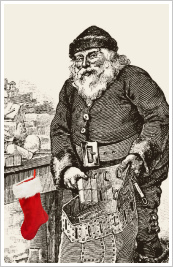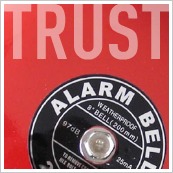You’ve come to the right place for buzzword-free info about work, workplaces, and workplace improvement. These posts are all about improving work processes, strengthening teamwork, sharpening management skills and leadership skills, improving communication, and more. This is info you can use right away, full of practical ideas in straight-talking plain English. Enjoy!
• Have a suggestion or question for a possible future post? Please let us know.
A Walmart reminder: Use your strengths

The moment I heard that rich baritone, I had to know: Who is this guy?
His was a voice like no other: rich, resonant, confident, congenial. The words sounded like warm syrup as they rolled from the store entrance to the checkout area where I was waiting in line.
He poured forth every time a shopper arrived or departed: “Welcome to Walmart. So glad you’re here.” “Thank you for shopping at Walmart. Hope you have a fantastic day. Please come back, we’d love to see you again.”
When I reached the checkout clerk, I asked about the vocally gifted greeter. The woman chuckled. “Oh, he’s my husband,” she said. “He does have a nice voice, and let me tell you, I hear it all the time.”
She knew him well so I had to ask: “Has he thought about doing voice-over work for radio or TV? What about being a DJ or a sports announcer or something like that? He could record audiobooks. He could do commercials. He could do all sorts of things. The man has a gift!”
She gave me the smile of someone who had heard it a hundred times. “When you leave,” she said, “tell him what you just told me.”
I did, and he responded with a gracious thank-you. “I hear that all the time,” he said.
“Well, what about it?” I asked. “Have you contacted any radio or TV stations or whoever needs great voices? Do you have a demo tape?”
He looked surprised. “Who, me?”
“Absolutely,” I said. “You have a real gift.”
As we shook hands and said goodbye, he softened his voice to say one last thing: “You really think so?”
Who knows what it was: excessive humility, skepticism, self-doubt, a lack of self-awareness. Something was keeping him from fully appreciating and exercising his extraordinary strength. He’s using it well at Walmart, of course, but could he use it there and beyond?
The truth is, each of us has a great strength that remains largely untapped. It might not announce itself so frequently or publicly, but it’s there. You know it is.
What’s yours?
5 gentle cures for chronic talkers

If you’re a nonstop talker who fills every conversation with your own ideas and observations, please hear this:
PEOPLE ARE TUNING YOU OUT.
It doesn’t matter if you’re a full-throttle genius, a gifted orator, a high-titled leader, or a beloved figure who’s respected by all. Anyone who can’t turn it off at least some of the time will be turned off by most people all of the time.
Now, it can be difficult for any of us to tell whether we have over-talking tendencies.
So play it safe by putting these talk-less tips to work:
1. Resist the urge to speak first or last at meetings. Both slots are an invitation to discussion domination.
2. Make a point of asking questions to get input from your colleagues. If it doesn’t come naturally to you, prep for meetings by writing a few questions on the topic at hand.
3. For an entire week, make it your mission to speak less and listen more. Think of it as your own strenuous personal-development exercise. Don’t announce it, just do it. And when it gets impossibly difficult, keep doing it. Reserve 10 minutes at the end of each day to review your progress.
4. Pick out one person in your workplace who speaks less and accomplishes more. Watch their approach and uncover the three or so things they do that make a difference. Then do the same in your own interactions.
5. Whenever you get the sense that you’re talking too much, you probably are. End your comments promptly with four simple words: “What do you think?”
10 secrets from the ultimate servant leader

It’s bigger than Walmart, more magical than Disney, and faster than FedEx.
Its leader has the intelligence of an Einstein, the creative powers of an Edison, and the caring spirit of a Mother Teresa.
His look is unconventional: lots of red, white fur trim, big white beard, red stocking hat, massive belt, all-weather boots, clay pipe. His well-fed rotundity is matched by a gymnast’s agility and marathon-runner’s endurance.
Santa Claus has turned his North Pole operation into the biggest and best organization the world has never seen. But how?
Here’s the answer in the form of 10 big strategies. Put them to work in your own life and you’ll see some real magic.
1. Defy gravity by having a meaningful mission
Is Santa a toy manufacturer? Is he a distributor? Is he a delivery specialist? He’s all of those and more, but his work is fueled by a higher purpose. Santa is in the inspiration business. He inspires us to appreciate our friends and family, to be generous, and to recognize that goodness is alive and well in our world.
2. Be a believer
Aren’t we straining reality to think that reindeer can fly? Perhaps. But you don’t bring a Santa-sized mission to life by being a skeptic.
3. Have a sense of humor
How does Santa Claus stay calm in the face of so many responsibilities? Humor. The man is jolly personified. When the going gets tough, he always finds good cause to ho ho ho.
4. Be willing to get dirty to get the job done
Does Santa go up and down chimneys because he’s fond of soot? Hardly. He does it because it’s the quickest and quietest way to get inside without a house key.
5. Encourage the copycats
With thousands of people pretending to be Santa each year, doesn’t the real Santa want to lawyer up and sue their beards off? Just the opposite. He encourages the well-intended wannabes, seeing them as a way to be in countless places at the same time.
6. Make the most of the most extreme differences
Does Santa Claus look for certain “types” to work at the North Pole? He focuses on strengths. When thick fog and heavy snow threatened delivery one year, Santa turned to a young novice who had become something of a laughingstock. The newly empowered Rudolph used his blazing beacon to lead the other reindeer to a safe and on-time delivery.
7. Be thoughtful about who and how you serve
Isn’t the “naughty and nice” list a bit harsh? Sure it is. But Santa knows that his mission would be compromised if he gave gifts to just anyone.
8. Get creative in living your mission
Does Santa fly past the children who fall short in a given year? No. He leaves each of them a nice bag of coal. It’s mostly designed to nudge kids in the right direction — but it can also be used to heat the home, boil water, and cook food.
9. Be yourself no matter what
Doesn’t Santa feel a bit silly prancing around in his fur-trimmed outfit and soup-catching beard? Not at all. He enjoys being himself. And as the greatest organizational success story of all time, he knows that his standout qualities keep the Santa brand eternally strong.
10. Savor your accomplishments
Does Santa get compensated? Yes, in three ways. Part of his pay is served up when he returns from his annual deliveries. That’s when he sits with colleagues to enjoy a huge stack of fresh-baked cookies. Santa’s second form of pay comes not from the kitchen but from the heart and mind. As he rests in his elf-made recliner, he contemplates his mission: Did he walk the talk of generosity? Check. Did he stir our imagination? Check. Did he renew humanity’s faith that goodness still exists? Check. Did his work inspire others to follow suit? Check. Then he settles back in his recliner, closes his eyes, and welcomes his third form of compensation: a long and well-earned rest.
When trust is in trouble: The top 10 alarms

You already have one of the best tools for taking stock of trust in your workplace. It’s with you at all times — in the form of your own two ears.
By listening for certain comments, you can gauge the extent to which trust is calling out for improvement. You can also gain insights into how trust can be improved.
What should catch your ear?
Below are 10 behaviors that spell trouble for trust. Included with each is a sample comment similar to what you might be hearing in your own workplace. You’re going to hear it before you see it, so stay alert.
1. Placing blame: “If he hadn’t spent so much time analyzing the data, we would’ve met the deadline.”
2. Selectively sharing information: “She’s the only person in the team who should get this information.”
3. Telling secrets: “Don’t tell anyone here that I told you this, but…”
4. Acting locally: “Let’s focus on what our work unit needs. The other units can fend for themselves.”
5. Dredging up the past: “He really dropped the ball on this three years ago.”
6. Asking for guarantees: “Will you put in writing what you’re promising to do?”
7. Doing inspections: “Let me take a look at your work before you move on to the next stage.”
8. Undoing commitments: “I wish I could follow through on what I said, but the situation has changed so much since then that there’s no way. ”
9. Harboring doubt: “I’ll believe it when I see it.”
10. Hedging: “I trust you, I really do, but…”
Dr. King and you: 5 ways to follow his lead

On the third Monday of every January, America honors Dr. King for his good works and great legacy. But 365 days a year, we all have the chance to follow his lead and make a difference. Here are five ways:
Devote yourself to a positive purpose: At age 14, Martin Luther King Jr. won a speech contest with his entry on “The Negro and the Constitution.” On the bus trip back home, he and his teacher were forced to stand while the white people sat. He could have turned bitter, but instead, he resolved to take positive action. He made it his mission to create a world where people are judged not “by the color of their skin, but by the content of their character.”
Turn weaknesses into strengths: Young Martin had wisdom beyond his years and a high IQ to match. He skipped kindergarten and entered first grade at age 5. He skipped his senior year and headed to college at age 15. He moved forward so quickly that his reading skills fell behind. Many people would have steered clear of their weakness by avoiding books, but Martin Luther King did just the opposite. He became a voracious reader and writer — and a lifelong seeker of knowledge and insight.
Exert discipline to get the job done: At age 25, he was pursuing his doctoral degree while serving as a church pastor — enough responsibility to keep several people busy. He applied extraordinary discipline, waking well before sunrise to work on his doctoral thesis, then plunging into his pastoral duties, then ending each day with more work on the thesis. He earned his Ph.D. in 1955, but he didn’t stop to rest. He promptly took on new challenges.
Use your gifts to the full: Dr. King ably used his great gifts of communication. Before and after his Dream soared from the Lincoln Memorial, he spoke out time and again from pulpits, parking lots, courtrooms, classrooms, legislative halls, and the Oval Office. Even in isolation, he kept up his mission of creating a better future, sending the nation his “Letter from a Birmingham Jail.”
Strive for excellence every day: Six months before his great life was cut short, Dr. King spoke to a group of students. He talked to them about the importance of having a “life blueprint” — a deeply held design of what each of them intended to accomplish in life. He encouraged them to strive for excellence at all times. His words apply to all of us: “If a man is called to be a street sweeper, he should sweep streets even as Michelangelo painted, or Beethoven composed music, or Shakespeare wrote poetry.”




